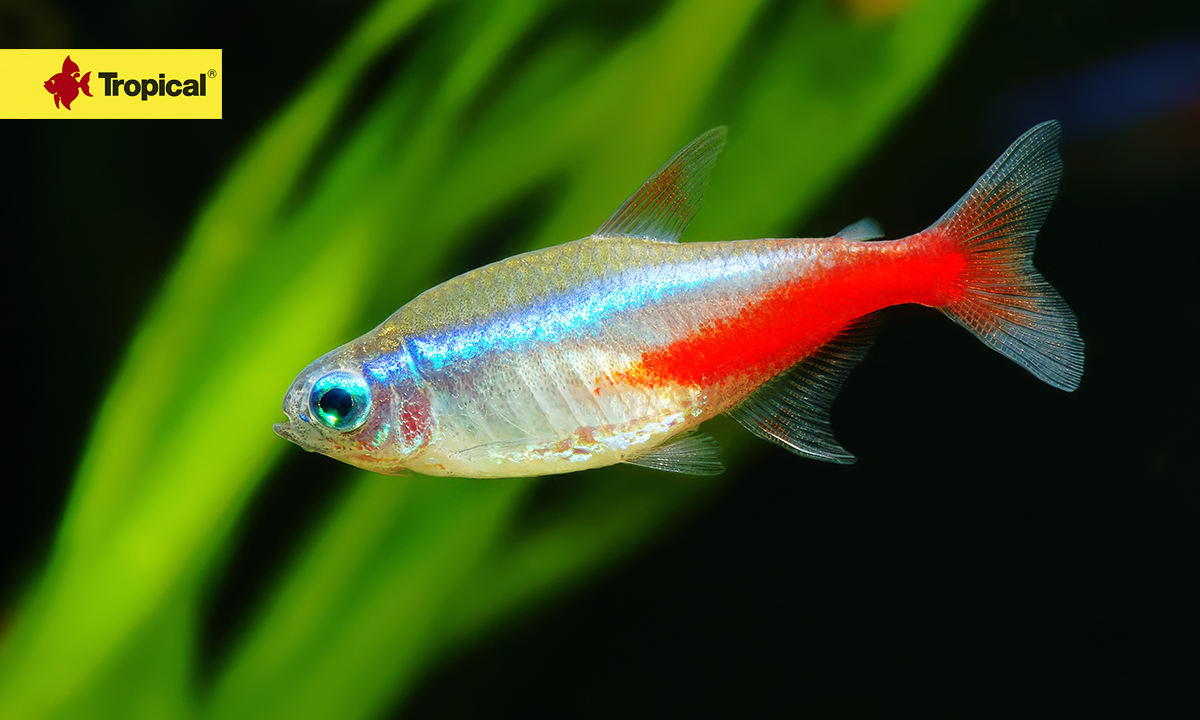Neon tetra (Paracheirodon innesi) – a real living jewel in your aquarium
Neon tetra (Paracheirodon innesi) is a very popular small representative of Characidae family. Thanks to its small size and beautiful colors it can be very often observed in general aquariums.
Where do neon tetras live?
In the wild, neon tetras inhabit small forest streams in the rainforests of South America. They are most often observed in acidic and soft water, rich in tannins and humic acids, the so-called black waters.
Characteristics of neon tetras
Neon tetras only grow to about 3.0-3.5 cm. This is a flocking species, so the more tetras there are in the aquarium, the safer and more secure they feel. Despite their small size, they attract attention with their characteristic coloration. They stand out even in heavily planted tanks with lots of other fish. It’s mainly due to their blue “glowing” neon bar running from the head to the base of the adipose fin. Such shiny elements in the coloration of Characidae family allow communication between individuals. This is very useful in the black waters they inhabit, where visibility is limited due to the color of the water. Another interesting fact is that this blue color is not the result of neon tetras having blue pigment. This is known as “structural” color, which is formed by certain arrangement of different pigment cells, containing guanine, carotenoids and melanin, in relation to each other. Sexual dimorphism is poorly marked in neon tetras. In mature fish, you may notice that males are slightly smaller and more slender than females.
Neon tetra or cardinal tetra?
Most often, neon tetra (Paracheirodon innesi) is confused with cardinal tetra (Paracheirodon axelrodi). However, when you take a good look at these two fish, you can see that the cardinal tetra is slightly larger with more intense coloration. A red bar runs in this species from the mouth to the base of their tails. In neon tetras, on the other hand, it is shorter, starting only at the level of the beginning of the anal fin.


A somewhat similar species, sometimes also confused with neon tetra, is the green neon tetra (Paracheirodon simulans). In his case, however, the red bar is barely visible, and the main characteristic is the distinct blue bar running from the eye to the base of the tail.

What aquarium do neon tetras need?
For a group of fish consisting of 10-15 individuals, an aquarium of 60 liters will be sufficient. Neon tetras look very well in densely planted tanks. Therefore, using plants, roots or dry leaves, you can create an extremely attractive tank. Remember, however, that fish feel better in twilight, which can be difficult to find in planted aquariums. That’s why it is worth using floating plants, which are great for helping to diffuse light.
What conditions do neon tetras need?
Commercially available neon tetras are farmed fish that do well in water of neutral pH and medium hardness that characterize most general tanks. Nevertheless, when preparing the aquarium specifically for them, it is worth ensuring that the water has a pH below 7 and is rich in humic compounds. For this purpose, you can put peat in the filter, and as decorative elements use roots, alder cones, beech leaves or ketapang. You can also use ready-made products such as Torfin Complex, Querex and Ketapang Extract. Humic compounds improve fish’s health and bring out their beautiful colors. If the tap water you want to use in the aquarium is very hard, the above methods will not work. In that case you need to purchase a reverse osmosis (RO) filter or distilled water and use it for water changes. Keep temperature at 24-27oC.
What are best companions for neon tetras?
Neon tetra is a gentle fish, so it is perfect for social tanks. However, when setting up such an aquarium, carefully select the stock so that neon tetras do not become a snack for their larger companions. Disappearing neon tetras are usually the result of larger predatory fish eating them out. Angelfish and catfish would surely enjoy such a snack, although there are exceptions to the rule. Personally, I would recommend combining neon tetras with other small Characidae fish, Corydoras or South American cichlids. The choice of species with similar requirements from the black water biotope is huge, so you will have no problem creating a colorful aquarium with fish from South America.
What do neon tetras eat?
In aquarium they eagerly accept ready-made flake and granulated foods. However, you need to remember to adjust the size of the food to their small mouths. For neon tetras, we recommend: Soft Line America S, Supervit Mini Granulat, Krill Flake, Nanovit Granulat, Red Mico Colour Sticks, Pro Defence S.










